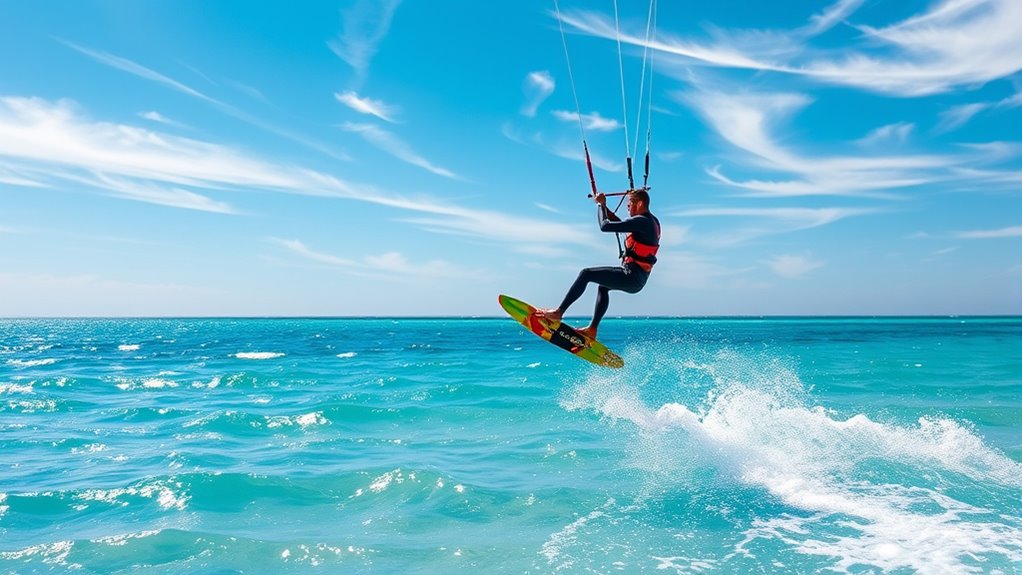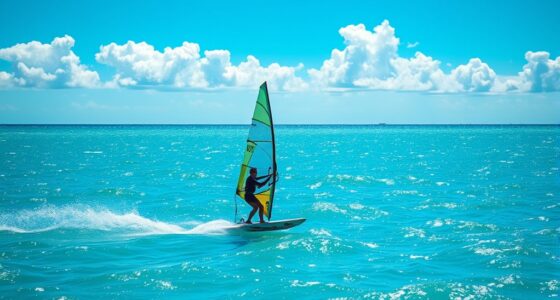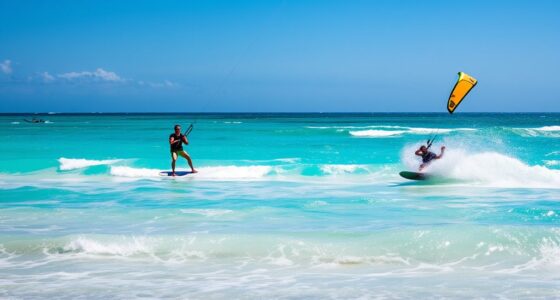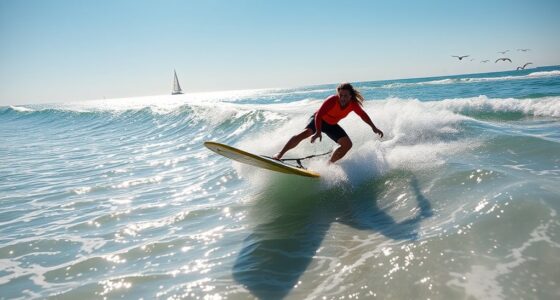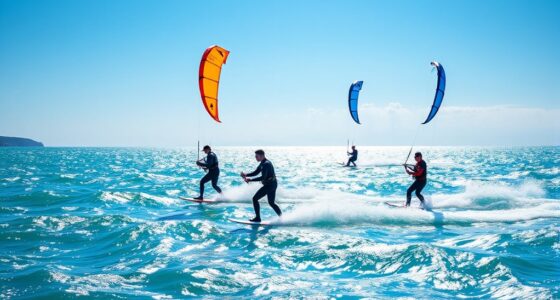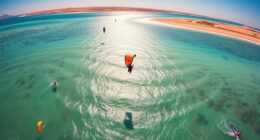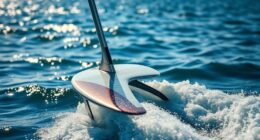A tiny wing in kitefoiling lifts you above water by creating a pressure difference through its shape and angle of attack. As wind moves over the curved surface, it speeds up airflow, decreasing pressure above the wing while maintaining higher pressure below, generating lift—guided by aerodynamic principles. Water beneath the foil adds stability, working with hydrodynamics to balance forces. Mastering these physics helps you achieve smooth, effortless lifts—keep exploring to learn more about how these forces work together.
Key Takeaways
- The tiny wing generates lift by creating a pressure difference through its curved shape and angle of attack.
- Faster airflow over the wing’s top surface lowers pressure, producing upward lift according to Bernoulli’s principle.
- Water beneath the wing provides a stable platform, with hydrodynamics working with aerodynamics to maintain balance.
- Adjusting the wing’s angle of attack controls the amount of lift and stability during the ride.
- Small wings can produce significant lift efficiently by focusing force and flow dynamics into a smooth, controlled glide.
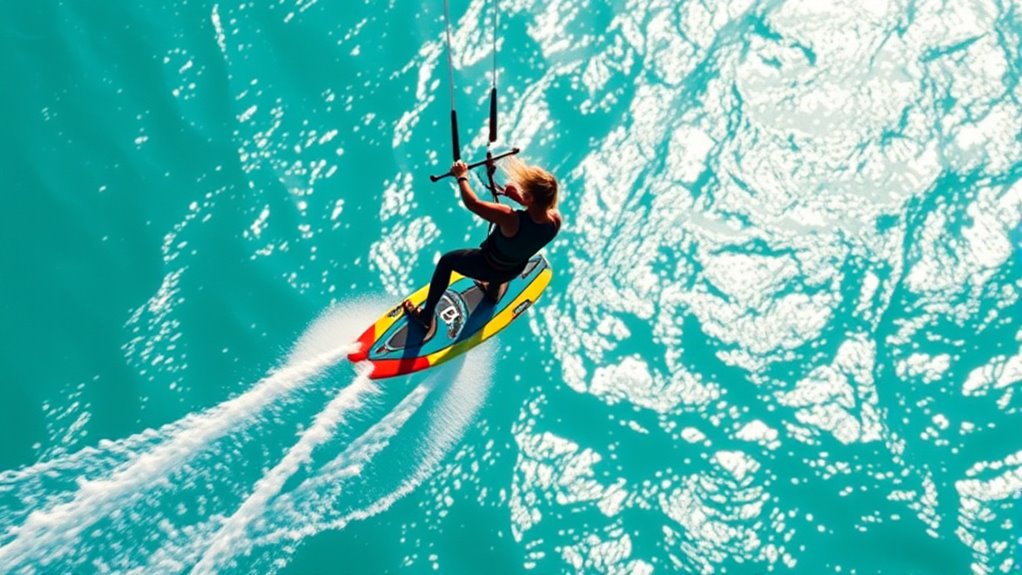
Kitefoiling physics combines principles of aerodynamics, hydrodynamics, and force balance to create a thrilling and efficient way to glide over water. At the core of this experience is the tiny wing beneath your board, which uses aerodynamic lift to elevate you above the water’s surface. Understanding how this lift works starts with wing design. The shape, size, and angle of your wing directly influence how much lift it generates and how stable your ride feels. A well-designed wing features a streamlined profile that minimizes drag while maximizing lift. Its curved surface helps accelerate airflow over the top, creating lower pressure above the wing and higher pressure underneath, in accordance with Bernoulli’s principle. This pressure difference produces the aerodynamic lift that keeps you afloat.
Effective kitefoiling relies on wing design, shape, and angle to generate lift and maintain stability over water.
As you harness the power of wind through your kite, the force is transferred to the wing via the foil’s connection to your board. When the wind pushes against the wing at a certain angle, it generates lift, helping you rise above the water. The wing’s design determines how efficiently this process occurs. For example, a wing with a thicker profile may produce more lift at lower speeds, making it easier to get started, while a thinner, more aerodynamic wing can reduce drag and allow for higher speeds and sharper turns. Your ability to fine-tune the wing’s angle of attack enables precise control over lift and stability. Slight adjustments can mean the difference between a smooth glide and a wobbling, unstable ride.
The physics behind this lift isn’t just about shape; it’s also about flow dynamics. When wind flows over your wing, air moves faster over the curved top surface, creating a pressure differential that lifts you. Meanwhile, the hydrodynamics of the water beneath the foil work in tandem, providing a stable platform that responds to the forces acting upon your wing. Your skill in balancing these forces—adjusting your kite, shifting your weight, and controlling the wing’s angle—determines how effectively you stay above water. The design of your wing plays a pivotal role in this balance, as a well-crafted wing offers predictable lift and smooth handling, making your ride more enjoyable and efficient.
Additionally, understanding the pimple patch technology used in skincare reveals how small, targeted solutions can be highly effective, similar to how a tiny wing can generate significant lift in kitefoiling. In essence, mastering kitefoiling physics means understanding how aerodynamic lift is manipulated through wing design. By choosing and adjusting your wing properly, you harness the wind’s energy to effortlessly lift you above water, turning complex physics into a seamless, exhilarating experience on the water.
Frequently Asked Questions
How Does Wind Speed Affect Kitefoiling Lift?
You’ll notice that as wind speed increases, the kitefoil experiences more aerodynamic lift, helping you rise above the water. Stronger winds generate greater wind shear, which enhances lift by increasing airflow over the wing. However, too much wind can make control tricky, so it’s essential to find a balance. Fundamentally, higher wind speeds boost lift, but you need to manage the power to stay safe and enjoy smooth kitefoiling.
What Materials Are Best for Kitefoiling Wings?
Think of your kitefoiling wing as the backbone of your ride. You want a wing design that’s lightweight yet strong, like a well-built bridge. Materials like carbon fiber and reinforced plastics are best because they offer excellent durability and stiffness, ensuring your wing withstands the forces of the water and wind. Choosing the right materials helps you stay confident on the water, making every ride smooth and secure.
How Do Water Conditions Impact Kitefoiling Stability?
Water conditions considerably impact your kitefoiling stability by influencing hydrodynamic forces and water density. Rough, choppy water creates turbulent hydrodynamic forces, making it harder to control your board. Conversely, calm water offers more consistent hydrodynamic forces, boosting stability. Higher water density provides more lift and buoyancy, helping you stay steady. So, always consider water conditions—calm, smooth water enhances your kitefoiling experience, while rough water demands extra skill and caution.
Can Kitefoiling Be Done in Saltwater or Freshwater?
Kitefoiling is like sailing on glass, whether in saltwater or freshwater. You can absolutely kitefoil in either; the main difference lies in water density effects. Saltwater’s higher density provides more lift, making it slightly easier to stay afloat. Your kitefoil design remains the same, but understanding water conditions helps optimize performance. So, go ahead and enjoy kitefoiling in any water type—both are equally thrilling!
What Safety Precautions Are Essential for Beginners?
When starting kitefoiling, safety is key. You should always wear a helmet for protection, especially during beginner lessons. Take proper beginner lessons to learn essential skills and safety protocols. Always check your equipment, stay within your skill level, and be aware of your surroundings. Practicing in safe, open areas helps prevent accidents. Remember, prioritizing safety ensures you enjoy kitefoiling while minimizing risks.
Conclusion
As you glide atop the water, the tiny wing becomes your magic carpet, effortlessly lifting you above the waves. Its delicate dance with wind and water transforms you into a soaring bird, weightless and free. Remember, this miniature marvel harnesses unseen forces, turning chaos into grace. So, embrace the physics, trust your wing, and feel the thrill of riding the wind’s whisper—your journey above water is a symphony of science and adventure.

